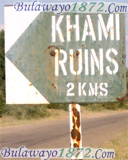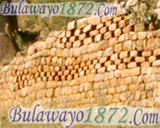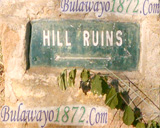|
|
|
|
| Trail Guide to Khami Ruins by E.G. Hughes |
|
| |
| INTRODUCTION |
| |
| The area around Khami has a long
history of occupation. Stone Age hunter-gatherers lived
in the area long before the stone walls belonging to the
Iron Age town were built. By the end of the first
millennium A.D. a village, belonging to iron and pottery
using farmers, had become established on and around a
rocky outcrop known as Leopard's Kopje to the north of
the river. Occasional glass beads from excavations there
indicate the beginnings of trading contacts with the
east coast of Africa. |
 |
The 13th and 14th centuries saw the emergence of a powerful African state centred on Great Zimbabwe 250km to the southeast. Perhaps influenced by Great Zimbabwe, the construction 9f stone structures began at Khami during the 15th century. At Great Zimbabwe the stone walls were used to enclose and divide up space between clay (daga) huts. At Khami the basic form of most stone structures was a raised platform on which the huts were located. These platforms were partially or entirely constructed by the heaping of stone and gravel behind a retaining wall. |
|
| Khami also has a larger number of walls with decoration than Great Zimbabwe, the most common forms being a check pattern and lines of darker dolerite stones. Despite these architectural differences, Khami clearly belongs to the same cultural tradition as Great Zimbabwe. At both sites the stone structures were associated with status and prestige while the majority of the population lived in huts outside the stone walling. |
|
|
| |
Dateable imports from excavations conducted by K.R. Robinson between 1947 and 1956 indicate that trading contacts with the east coast settlements and the Portuguese continued during the 16th and 17th centuries.
|
 |
Historically, Khami has been identified as the capital of the Torwa state which appears to have inherited much of the power of Great Zimbabwe in southwestern
Zimbabwe. The Torwa state was in turn succeeded by the Rozvi kings who became established at other important stone wall settlements including those at Naletale and Danamombe (formerly Dhlo
Dhlo) near modem Gweru. |
The power of the Rozvi
was eventually eroded by the Nguni incursions from
the south during the early 19th century
culminating in the arrival of the Ndebele with Mzilikazi during the 1830s.
It is suggested that before touring the monument a
visit should be made to the site museum which
contains Stone Age and Iron Age exhibits from
excavations at Khami. |
|
|
| Tour One |
| The hill complex and neighbouring hut platforms (approximate duration 30-40 minutes)
The largest concentration of stone walling and terracing at Khami surrounds a prominent hill overlooking the Kame River. This was almost certainly the residence of the Mambo (king) although several ceremonial objects found during excavations suggest that it was also a centre of ritual in the Iron Age town. Broken pots and discarded animal bones from refuse heaps or middens, litter the surrounding paths and slopes.
The complex is composed of three large hut platforms rising in tiers. Many of the retaining walls are decorated with a check pattern. The uppermost platform contains the remains of at least nine huts and is divided by two winding passages which were originally roofed with daga. |
|
|
Tour One: POINTS OF INTEREST - Hill complex
1. A small hut was originally located on top of the southern passage.
2. The walls of this recessed chamber were originally plastered with daga. Two decorated stones can be seen where the plaster has now fallen away.
3. Originally wooden posts can be seen lining the passage. Some clearly supported the roof. Others may have been decorative.
4. Semicircular hut - this appears to have had a flat roof similar to that of the passage. |
 |
5. Three daga steps appear to have originally led onto the roof of the hut. A hoard of bronze and iron weapons was found on the lowest of these steps. These are now on display in the National History Museum, in Bulawayo. This hoard, together with finds of ivory divining dice and other carved ivory artifacts, suggest that the hut had a ceremonial or ritual use. |
|
6. Hut remains - this hut, which was roofed in 1988 to protect the fragile remains of its walling, was one of the largest huts on the hill. Nearby was an even larger hut with an internal dividing wall. Many of the huts were linked by radial walls of stone and daga and they were all roofed with thatch.
7. On of the smallest huts, which contained the zoomorphic pot now on display in the site museum. This may have been used in rainmaking
ceremonies.
8. Megalithic wall - an unusual wall constructed of large, untrimmed granite boulders. Nearby is a view overlooking the
Khami River. |
9. Cross platform - a roughly circular platform with a double entrance
and the remains of at least three huts. The line of wooden posts set into the retaining wall near to the entrance, may have been decorative. The restored stone cross is said to have been placed there by a Portuguese missionary although there is little supporting evidence.
10. North Platform - this is fronted by a highly decorated wall.
11. Several of the kopjes to the west of the hill complex contain the remains of smaller hut platforms.
12. Circular hut - the remains of a circular daga hut surrounded by a stone wall and a series of stone built steps. It was probably roofed with daga on a frame of wooden poles. It may have been used a.s a large grain store or a funerary hut.
|
|
|
| TOUR TWO - Outlying Hut Platforms (Approximate duration 45-55 minutes) |
| Several stone walled hut platforms of various sizes are located in the area to the south of the hill complex. They may have been the residences of the king's wives, his courtiers or other important individuals within the society. The paths near to the dam wall can be steep but the walk is rewarding both for the archaeology and for the wild life. |
|
Tour Two - POINTS OF INTEREST
13. Tsoro game board - several examples can be seen at
Khami, marked out on granite boulders. This game, which is still played, uses small rounded river pebbles as counters.
14. Monolith platform - named after the large granite boulder over looking the platform.
15. Passage platform - this approximately circular structure combines the use of rivetted platforms and free standing walls. The walls either side of the entrance to an 18 metre long passage are decorated with lines of dolerite stones.
16. Precipice platform - this has an exceptionally long retaining wall with a check decoration along its whole length. It is now partly submerged by the reservoir.
17. Rock gong - a balancing granite boulder near the dam wall which makes a bell-like sound when struck.
18. Vlei platform - an ivory figurine of a man was found within the small enclosure formed by boulders and a little walling in the centre of the platform. It is now on display in the Natural History Museum in Bulawayo.
19. Hut remains - the huts of the majority of the population were not located on stone walled platforms. Traces their remains can be seen on the surface of the ground to the west and north of the stone structures.
|
|
| Take a virtual
tour of Khami Ruins here |
|
FURTHER READING
BEACH, D.N. 1980. The Shona and Zimbabwe 90a-1850. Gweru: Mambo Press. .
CATON-THOMPSON, G. 1931. The.zimbabwe Culture.Oxford: Clarendon Press.
COOKE, c.K. 1974. A Guide to Khami Ruins. Salisbury: The National Museums and Monuments of Rhodesia. GARLAKE, P.S. 1973. Great Zimbabwe. London: Thanes and Hudson. HUFFMAN, T.N. 1974. The Leopard's Kopje Tradition. Museum Memoir
BEACH, D.N. 1980. The Shona and Zimbabwe 90a-1850. Gweru: Mambo Press. .
CATON-THOMPSON, G. 1931. The.zimbabwe Culture. Oxford: Clarendon Press.
COOKE, c.K. 1974. A Guide to Khami Ruins. Salisbury: The National Museums and Monuments of Rhodesia. GARLAKE, P.S. 1973. Great Zimbabwe. London: Thanes and Hudson. HUFFMAN, T.N. 1974. The Leopard's Kopje Tradition. Museum Memoir
National Museums and Monuments of Rhodesia 6. RANDALL-MACIVER, D. 1906. Mediaeval Rhodesia. London: Macmillan. ROBINSON, K.R. 1959. Khami Ruins. Cambridge University Press.
|
|
|
|
| |
| |
| |
|
| If you feel this is not an
accurate profile and you have a more accurate one, or
you have a clarification , you can submit your version of the Profile here |
| |
|
|
|
| |
|